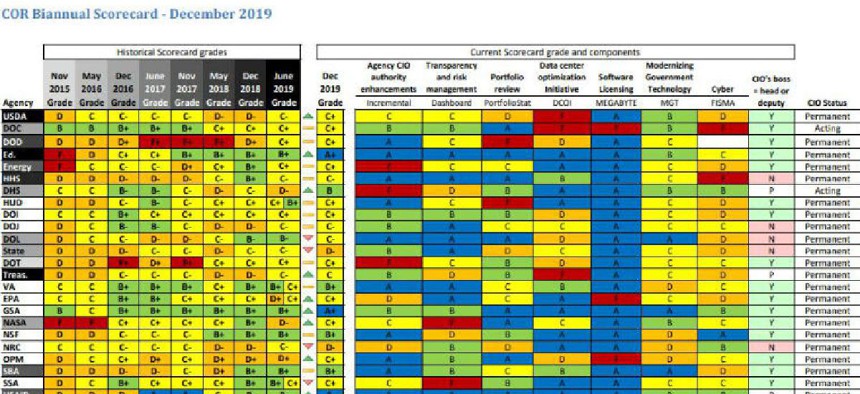FITARA scores trend up, but concerns on data centers, CIO authorities remain

At the ninth House hearing on implementation of the Federal IT Acquisition Reform Act, many agencies showed improvement, but lawmakers cited familiar problems.

At the ninth legislative hearing on implementation of the Federal IT Acquisition Reform Act, held by the Government Operations subcommittee of the House Committee on Oversight and Reform, many agencies showed improvement but lawmakers cited familiar problems, including data center consolidation and CIO authorities.
The good news for FITARA watchers is that nine agencies saw their grades go up, with some achieving A+ marks for the first time. Four agencies had their grades dip and 11 remained the same.
Measuring progress on the grades is complicated by the fact that the FITARA scorecard is a moving target, with new items added as IT legislation progresses. For instance, agencies appear to be responding very well to the software licensing inventory demands of the Megabyte Act of 2016, but they are slower in adopting the working capital funds authorized under the more recent Modernizing Government Technology Act.
On the CIO authority front, NASA CIO Renee Wynn reported that her agency's administrator had reversed a decision to exclude the CIO from being a direct report. NASA's CIO now reports directly to the agency chief, and all the CIOs at the various facilities report up to her.
A direct line to the boss is important, Wynn testified.
"It helps me when I am reporting in particular on significant cybersecurity events to be able to get easy access to the administrator.… I think there's a couple other issues in IT that get to be significant, and we certainly have easy access to report any of those issues to him," Wynn said.
At the Department of Homeland Security, which maintains CIOs for its large components, the situation is a little different, said acting CIO Elizabeth Cappello.
"My concern would be responsiveness to the operational tempos and to the individual mission sets," she said. "At DHS, there is an awful lot of value in the technologists being able to respond directly to the operational requirement."
Subcommittee Chairman Rep. Gerry Connolly (D-Va.) said he was attuned to the particular challenges of large federated agencies like DHS, but he said that "there's gotta be somebody who reports directly to the boss who has the authority, responsibility and accountability for management, procurement and reduction of legacy systems."
Connolly also said he was concerned about the Office of Management and Budget’s latest guidance on data center consolidation. because the language in the guidance includes "optimization" and not consolidation. That change, he said, could lead to billions in lost savings.
"Data center consolidation is what frees up capital. That's what gives you the cost savings. If you play games with the definition of what is a data center or what constitutes consolidation, you miss the benefits," Connolly said.
Ranking Member Rep. Mark Meadows (R-N.C.) indicated that the FITARA grades are working their way into how appropriators think about technology funding.
"We pay very close attention to this. It's actually now starting to become … indirectly part of the appropriations process," Meadows said. "We want to make it a more formal part of that where literally we reward you for doing a good job."
Federal CIO Suzette Kent praised agencies for their improvements on the FITARA scorecard in remarks at an industry conference earlier the same day. She called the new scorecard "the best ever."
Although grades don’t offer in-depth analysis of a given agency's effort to modernize their systems, Kent said they show the overall connection of the IT capabilities to the agency’s leaders, who are using it as a progressive tool for their mission and to serve customers. Conversations among agency secretaries, CIOs and agency executives are now about how to use technology to achieve mission goals and serve agency customers, according to Kent.
"That was part of the MGT Act and the executive order around CIO authorities. Changing those dialogues," she said, referencing two key IT modernization initiatives.
The high marks, she said in remarks to reporters after her presentation, provide "an opportunity to think about what’s next. I look forward to look at things beyond infrastructure and operational maturity to progress towards digital government and improvement of citizen services."
The common thread among those agencies' success, according to Kent, is that they hit all of the OMB requirements, including application rationalization, long-term plans, attention to data centers and workforce.
"The ones that got As did every one of those. Two of them not only did them -- GSA and the Department of Education -- [they] posted their playbooks for other agencies to use," she said.





